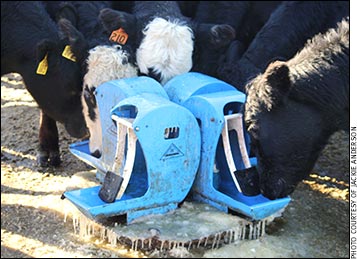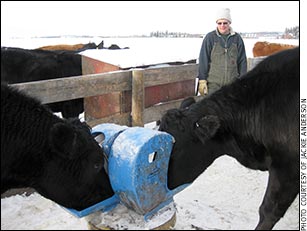Winter Water Solution
Frost-free nose pump eliminates winter water woes.

The Western Beef Development Centre Research Ranch in Saskatchewan has used nose pumps for four years.
George Widdifield, ranch manager at the Western Beef Development Centre’s Research Ranch in Saskatchewan, says their operation utilizes frost-free nose pumps for cattle in winter range pastures where there is no access to electricity.
The Research Ranch has used nose pumps for four years. These are a vertical culvert to access water from a nearby dugout or pond. A small drinking basin sits atop the culvert. A cylinder with a piston pump is inside the culvert, pumping water up to the basin when the cows push a lever with their nose. When the cow stops pumping, any water in the upright pipe drains back down so there’s no water left in it to freeze.
“These work fine, but the cows must learn to use it. We did it the recommended way, starting with just a few cows, and they teach the others. We’ve found that even in summer, when there is other water available, some cows prefer to use the nose pump to have cool, clean water,” says Widdifield.
One nose pump will easily water 100 head. With 400 head, a person can put four basins on top of the upright culvert. James Madge, a rancher in Alberta, has two sites with four basins at each site and waters 500 cows in that pasture all winter. He has another site with two on it, where he waters all his bulls.
“We’ve never heard of a nose pump being damaged, whether watering bulls or bison,” says Jackie Anderson, wife of Jim Anderson, who invented the nose pump 15 years ago.
“Using a nose pump eliminates the risk of losing cows through the ice on a pond. One cow saved from drowning in a dugout would more than pay for installing a frost-free nose pump. A rancher last year lost an entire herd because they were all out on the ice, milling around trying to find water,” Jackie says.

“We’ve never heard of a nose pump being damaged, whether watering bulls or bison,” says Jackie Anderson, wife of Jim Anderson, who invented the nose pump 15 years ago.
Don Viste, a rancher northeast of Calgary, Alta., says the nose pumps provide water for his 300 cattle.
“What started it for me was when we lost 29 head that fell through the ice on a dugout five years ago. That’s why we put in the nose pumps, but there are many other benefits besides making winter watering safer. It keeps the dugouts cleaner through the year because cattle aren’t wading into them,” he says.
Some ranchers in his area have 700-2,500 cows watering from nose pumps. Viste has 10 dugouts set up for nose pumps, but only needs three working at a time. He moves the upright culverts and drinking basins to various locations when he moves the cows.
“I have a trailer set up to do this, with timbers across it with slots cut out, to set everything in,” Viste explains. “I just pull up the culvert, set it on the trailer, and go to the next location. I use a loader to pull it up, and set it in at the next place. Most people don’t have as many dugouts as I do, and just leave the culvert/nose pump in a permanent location, but I move mine around as I move the cows.”
There are many ways to put in a nose pump. Some people install a large culvert in a spring, and divert water from the large one underground to a smaller one with the nose pump, to keep cattle away from the spring and keep it cleaner.
“One fellow had to lift water 300 feet,” says Jackie. “No nose pump can do that. He was away at work all week, so he buried a huge tank and pumped water into it on weekends when he was home. Then the cattle used the nose pump off that underground tank.”

Editor’s Note: Heather Smith Thomas is a freelance writer and cattlewoman from Salmon, Idaho.





